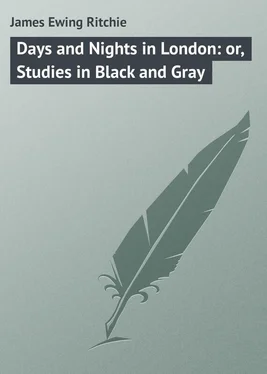James Ritchie - Days and Nights in London - or, Studies in Black and Gray
Здесь есть возможность читать онлайн «James Ritchie - Days and Nights in London - or, Studies in Black and Gray» — ознакомительный отрывок электронной книги совершенно бесплатно, а после прочтения отрывка купить полную версию. В некоторых случаях можно слушать аудио, скачать через торрент в формате fb2 и присутствует краткое содержание. Жанр: foreign_prose, на английском языке. Описание произведения, (предисловие) а так же отзывы посетителей доступны на портале библиотеки ЛибКат.
- Название:Days and Nights in London: or, Studies in Black and Gray
- Автор:
- Жанр:
- Год:неизвестен
- ISBN:нет данных
- Рейтинг книги:3 / 5. Голосов: 1
-
Избранное:Добавить в избранное
- Отзывы:
-
Ваша оценка:
- 60
- 1
- 2
- 3
- 4
- 5
Days and Nights in London: or, Studies in Black and Gray: краткое содержание, описание и аннотация
Предлагаем к чтению аннотацию, описание, краткое содержание или предисловие (зависит от того, что написал сам автор книги «Days and Nights in London: or, Studies in Black and Gray»). Если вы не нашли необходимую информацию о книге — напишите в комментариях, мы постараемся отыскать её.
Days and Nights in London: or, Studies in Black and Gray — читать онлайн ознакомительный отрывок
Ниже представлен текст книги, разбитый по страницам. Система сохранения места последней прочитанной страницы, позволяет с удобством читать онлайн бесплатно книгу «Days and Nights in London: or, Studies in Black and Gray», без необходимости каждый раз заново искать на чём Вы остановились. Поставьте закладку, и сможете в любой момент перейти на страницу, на которой закончили чтение.
Интервал:
Закладка:
In speaking of London we sometimes mean Smaller London and sometimes Greater London. To avoid confusion we must clearly understand what is meant by each. Smaller London comprises 28 Superintendent Registrars’ Districts, 20 of them being in Middlesex, 5 in Surrey, and 3 in Kent; viz. Kensington, Chelsea, St. George, Hanover Square, Westminster, Marylebone, Hampstead, Pancras, Islington, Hackney, St. Giles, Strand, Holborn, London City, Shoreditch, Bethnal Green, Whitechapel, St. George in the East, Stepney, Mile End and Poplar in Middlesex; St. Saviour, Southwark, St. Olave, Southwark, Lambeth, Wandsworth, and Camberwell in Surrey; and Greenwich, Lewisham, and Woolwich in Kent. It had an estimated population in the middle of 1878 of 3,577,304. Greater London comprises in addition to the above 14 Superintendent Registrars’ Districts, 6 of them being in Middlesex, 4 in Surrey, 2 in Kent, and 2 in Essex; viz. Staines, Uxbridge, Brentford, Hendon, Barnet, and Edmonton in Middlesex; Epsom, Croydon, Kingston, and Richmond in Surrey; Bromley and Bexley in Kent; and West Ham and Romford in Essex. It comprises the whole of Middlesex, and such parishes of Surrey, Kent, Essex, and Herts as are within 12 miles of Charing Cross. These additional districts had an estimated population of 872,711 in the middle of the year 1878, so that Greater London has therefore at the present time a population of 4,450,015. The population of the United Kingdom in the middle of 1878 was estimated at 33,881,966. Greater London had therefore considerably more than an eighth of the population of Great Britain and Ireland, and more than a sixth of the population of England and Wales. This large population is constantly and rapidly increasing; the estimated increase in 1878 being 82,468. It is important to note that the increase is not equal in all parts. The population is decreasing within the City; within Smaller London it goes on increasing but at a decreasing rate, and in the outer ring the population increases steadily at an increasing rate. The population of the outer circle has increased more than 50 per cent. in the last ten years.
Even in its narrowest definition – as the small plot of ground between Temple Bar and Aldgate pump – what a history London has! Of what scenes of glory and of shame it has been the theatre! What brave men and lovely women have played their part, heroic or the reverse, upon its stage! When the City’s greatest architect dug deep into the earth to build the foundations of his matchless cathedral, he laid bare the remains of nations and generations that one after another had held the City as its own. First he uncovered the graves of the early medieval Londoners; then he came to the remains of our Saxon forefathers, of Ethelbert and St. Augustine; next were found the remains of Romans and ancient Britons, and last of all were found the mouldering remains of those who knew not Cæsar and the city they call Rome. Again, the London of Victoria faintly resembles the London of Queen Anne, as faintly perhaps as does the Jerusalem of to-day represent the city in which our Saviour dwelt. No wonder that our old chroniclers romanced not a little, and that many of them did believe, as Geoffrey of Monmouth writes, that London was founded by Brute, a descendant of Eneas, eleven hundred years before Christ, and that he called it Troy Novant, whence came the name of the people to be called Trinobantes. Equally widespread and equally unfounded was the belief that from London were shipped away eleven thousand – some say seventy thousand – British virgins (as an admirer of the virtues of my countrywomen I stick to the highest figure) – whose bones may yet be seen in Cologne – to the British warriors compelled to settle in Armorica. What is clear, however, is that in London Diana had a temple, that the Saxons won the city from the Britons, that the Tower of London is one of the oldest buildings in Christendom, and that here Roman and Dane, and Saxon and Norman have all more or less left their mark. Our early monarchs trembled as they saw how the great city grew. When that slobbering James came to the throne – whom his courtiers denominated the British Solomon – of whom bishops and archbishops testified that his language was that of inspiration, he exclaimed, “England will shortly be London, and London England,” as he saw how people were adding house to house and street to street, and flocking to them from all parts of England and Scotland; yet the London of the Stuarts, neither in extent or magnificence or wealth, bore the faintest resemblance to the London of to-day.
Londoners are well looked after in the matter of taxes. The ratable value of the metropolis, or rather the district of the Metropolitan Board, is £23,960,109. Last year it raised in this way £477,835. The School Board rate was something similar. Besides, there is a sewer rate of twopence in the pound; a paving, watering, etc. rate of probably ninepence; a lighting rate of threepence; then there are rates to pay interest on the debts of extinct paving trusts; a rate for baths and wash-houses, police rate and county rate, making a total of almost five shillings and sixpence in the pound on the value of a house. While it has an excess of beer-shops, gin-palaces, and music-halls, it has a great deficiency as regards church and chapel accommodation. In Inner London it is calculated 955,060 sittings are required. In Larger London the deficiency, it is estimated, is much more.
The number of police, according to the last return, was 10,336 in the metropolis, showing an increase of 0.5 per cent. over last year; and in the City 798, being seven over the last returns. The metropolitan police are in the proportion of one for every 397 of the population of the metropolitan police district; the City police of one for every 93 of the population, as enumerated on the night of the census of 1871. The cost of the metropolitan police was £1,077,399, of which 39.9 per cent. was contributed from public revenue; the cost of the City police was £85,231, towards which no contribution was made. From the criminal returns it appears that for the metropolitan police district, with the City, the number of known thieves and depredators, receivers of stolen goods, and suspected persons, was 2,715, or one in 1,431 of the population, showing an increase of 3.9 per cent. on the returns of the previous year. The rule which has been followed now for 14 years, that persons known to have been living honestly for one year at least subsequently to their discharge after any conviction, should not be returned in the class of known thieves and depredators, has been adhered to. The return of houses of bad character in the metropolis, exclusive of those of ill-fame and of those returned to Parliament under the Contagious Act, is 215, of which 66 are houses of receivers of stolen goods, showing a decrease of 22 in the year. The total number of cases tried at the Central Criminal Court was 10,151. From a classification of offences determined summarily we learn that there were 5,622 persons proceeded against in the City, of whom 1,093 were discharged, and the remainder convicted or otherwise dealt with. There were 191 offences against the Adulteration of Food Act in the metropolitan police district, 7 in the City; 5,874 against the Elementary Education Act, none in the City; 1,234 cases of cruelty to animals in the metropolitan district, 823 in the City; 33,520 persons were drunk and disorderly in the metropolitan district, 431 in the City, being an increase over the numbers for the last year of about 1,000 in the first instance, and 35 in the second.
Читать дальшеИнтервал:
Закладка:
Похожие книги на «Days and Nights in London: or, Studies in Black and Gray»
Представляем Вашему вниманию похожие книги на «Days and Nights in London: or, Studies in Black and Gray» списком для выбора. Мы отобрали схожую по названию и смыслу литературу в надежде предоставить читателям больше вариантов отыскать новые, интересные, ещё непрочитанные произведения.
Обсуждение, отзывы о книге «Days and Nights in London: or, Studies in Black and Gray» и просто собственные мнения читателей. Оставьте ваши комментарии, напишите, что Вы думаете о произведении, его смысле или главных героях. Укажите что конкретно понравилось, а что нет, и почему Вы так считаете.












